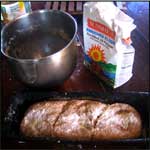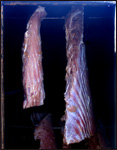 What advice would you give women in setting up their galleys, in preparing to cook aboard? What advice would you give women in setting up their galleys, in preparing to cook aboard?
If you depend on electric power to cook onboard, you are in trouble.
Cruising is about relaxing: don't become a slave of electric power. You cannot afford the stress of not being able to cook dinner at sea when some electric equipment fails.
Cook with gas (or kerosene).
There is only one electric appliance that you truly need: a 12V fridge. Add a blender or a mixer. Other appliances - toaster, food processor, coffee maker, bread machine, rice cooker, micro-oven - can help too. But, unless you are a charter chef, see them as luxury items. They burn amps (navigation equipment, lights, computers, watermaker … need power too) and waste storage space. They are meant to save time: you will probably have time to waste.
Treat your fridge like your best friend. But don't get attached to it: you must be psychologically ready to face life without refrigeration for a couple of days (weeks?). It might stop working miles away from a good refrigeration technician…
Be a stainless steel fanatic.
Good stainless steel is beautiful, easy to clean and lasts forever.
Cast iron rusts, aluminum corrodes, plastic breaks or scratches, china or enamel chips, wood splits … more quickly at sea. You find the best stainless steel cooking equipment in restaurant supply stores.
But nothing is perfect in life: stainless steel knives are more difficult to sharpen than steel knives.
Get organized for making "home" products.
 |
|
 |
Bread dough,
ready for the oven |
|
Tuna hanging
in smoking oven |
Bring your grandmother's cookbook if you can: you might want (or need) to make your own bread, jams, chutneys, yogurt, pickles, sauerkraut or mayonnaise, or simply to can food for long passages.
Try to always carry enough supplies for preserving food: empty jars, extra reserve of white sugar, salt, vinegar and cooking fuel. Opportunities when perishable food is cheap (or free) and plentiful often come unexpected.
Unfortunately I can't tell how long "home"-canned food may keep. Anything I can - especially jams - usually disappears from the locker within 2 weeks!
“I can't cook because I have to take care of the [engine]".
Cooking “contests” produce better and more varied food. How many hours a week does the [engine] need care compared to cooking time? Help “fixing the engine” and share the cooking duties ...
|